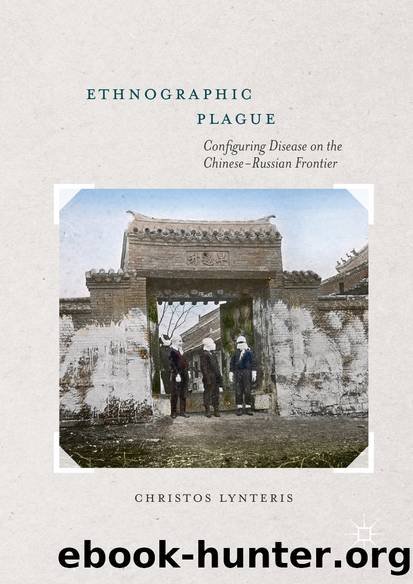Ethnographic Plague by Christos Lynteris

Author:Christos Lynteris
Language: eng
Format: epub
Publisher: Palgrave Macmillan UK, London
Importing Plague
Jean-Jacques Matignon was born in Eynesse of Gironde in 1866. He graduated with a medical degree from Bordeaux in 1892 and was stationed in Beijing as an army doctor attached to the French Foreign Legation in 1895. Matignon was a prolific author on a wide array of medical issues in China, dwelling principally on exotic and sensational topics: Forbidden City eunuchs, âacromegalo-gigantismâ, foot-binding, Japanese maladaptability to Western boots, the Kangxi Emperorâs âneuropathyâ, an alleged anti-leper pogrom in Nanjing, and a type of food poisoning, which he named atriplicism, inflicting North Chinese beggars subsiding on an unwashed spinach-like herb. 8 This medico-orientalist trajectory reached its apex in the publication of his magnum opus on Chinese âsuperstition, crime and povertyâ. 9 At the same time, Matignon was a practical man. He was active in the Peking Hospital as well as in medical expeditions to Manchuria, covering public health aspects of the Russian-Japanese War. 10 Yet what sealed Matignonâs international fame was his role as acting chief doctor of the Peking Foreign Legations during the Boxer siege of 1899â1900. All in all it may be said that by 1905 Matignon was one of the most internationally recognised and admired French doctors operating in the Qing Empire.
It is not quite clear what first drew Matignonâs attention north of the Great Chinese Wall. As noted in the previous chapter, Matignon developed a long-standing ethnographic interest in the region, which included a brief research field trip to Urga. Whereas in the Mongolian capital Matignon investigated courtly medicine, in the case of his better-known research in Eastern Mongolia his interest consisted in the study of bubonic plague. The results of his plague expedition were first presented to the French Academy of Sciences in December 1897 and published in an extensive article in the Annales dâhygiène et médecine legale in 1898, and republished a year later in the Archives de médecine et de pharmacie militaires. 11
Matignon began his paper, La peste bubonique en Mongolie, by giving a brief account of the displacement of Mongols by the Chinese and their confinement in âthe great plateaux of Mongoliaâ. 12 Describing the mountain ranges separating China from Mongolia, Matignon noted that the region, which was once covered in woods, now stood completely deforested as a result of the recent authorisation of Chinese migration by the ruling Qing. 13 Twelve daysâ horse ride away from Beijing to the north-east took Matignon to the valley of Sô-leu-kôn (Selenga) and the village of Toung-kia-Yng-tze, where âsince nine years reigns the bubonic plagueâ. 14 Matignon wrote that the population of the valley was entirely Chinese: âthe first colonisers consisted in Christians from the Manchurian border, who appealed to workers, mainly from the province of Shandong, to help them in their work of deforestation.â 15
These Shandong migrants were looked down upon by the French doctor as paragons of hygienic backwardness. This discourse is typical of what I have described as the negative pole of colonial strategies of representation regarding infectious disease and native subjects. As
Download
This site does not store any files on its server. We only index and link to content provided by other sites. Please contact the content providers to delete copyright contents if any and email us, we'll remove relevant links or contents immediately.
| Africa | Americas |
| Arctic & Antarctica | Asia |
| Australia & Oceania | Europe |
| Middle East | Russia |
| United States | World |
| Ancient Civilizations | Military |
| Historical Study & Educational Resources |
The World Almanac and Book of Facts 2021 by Sarah Janssen(840)
The emperor wears no clothes by Jack Herer(353)
The Crises of Civilization by Dipesh Chakrabarty(310)
The Way Home by Unknown(308)
History of India: A History In 50 Events by Hourly History(272)
Hidden Links by Zac Sangeeth & Sangeeth Varghese(247)
Darius in the Shadow of Alexander by Pierre Briant(246)
The History of Human Marriage by Edward Westermarck(238)
Prehistoric Europe by Champion Timothy. Whittle Alasdair. Shennan Stephen. Gamble Clive(237)
A Military History of the Cold War, 1962â1991 by Jonathan M. House(235)
Flood Legends: Global Clues of a Common Event by Charles Martin(225)
History of the Jews: An Enthralling Guide from Ancient Times to the Present (Religion in Past Times) by Wellman Billy(214)
Chinese History: 500 Interesting Facts About China (Curious Histories Collection) by Ahoy Publications(201)
The Education of Historians for Twenty-First Century by Thomas Bender; Philip F. Katz; Colin A. Palmer(196)
Big Tent by Mallory Factor(190)
Ancient Roman Sports, A-Z : Athletes, Venues, Events and Terms by David Matz(184)
The Philosophy of Historiography by John Lange(182)
Other Pasts, Different Presents, Alternative Futures by Jeremy Black(180)
Mark Of The Scots - Cl by Duncan A. Bruce(179)
